Table of Contents
Introduction
According to Treadmill Statistics, Treadmills are versatile exercise machines designed for indoor walking, jogging, or running.
They come in two main types: manual, which operates without electricity, and motorized. Which features an electric motor to drive the belt and offer adjustable speeds and inclines.
The belt, deck, frame, control panel, and incline mechanism are key components. Motor power, belt size, cushioning, incline range, ergometer, and programming features are important factors when choosing a treadmill.
Regular maintenance, such as cleaning, lubrication, and inspection, ensures optimal performance and longevity.
Editor’s Choice
- The first patent for a treadmill as a fitness tracker was issued in 1913, and in 1952, Dr. Robert Bruce and Wayne Quinton developed the first medical treadmill to diagnose heart and lung conditions.
- In 2023, the global treadmill market revenue stood at USD 3,846.2 million.
- By 2033, the market is projected to reach USD 6,507.9 million. With electronic treadmill revenues at USD 3,709.5 million and manual treadmill revenues at USD 2,798.4 million.
- As of April 2022, NordicTrack emerged as the most commonly owned treadmill brand in the United States. With 31.9% of respondents indicating ownership of this brand.
- Wholesale sales of treadmills for consumers in the U.S. peaked at USD 1,034 million in 2018.
- The cost of treadmills in the industry varies significantly, ranging from as low as $100 to over $5,000.
- In the United States, treadmill regulations include compliance with standards set by the Consumer Product Safety Improvement Act (CPSIA). The Federal Communications Commission (FCC) Part 15 for radiofrequency devices, and energy efficiency standards under 10 CFR Part 430.
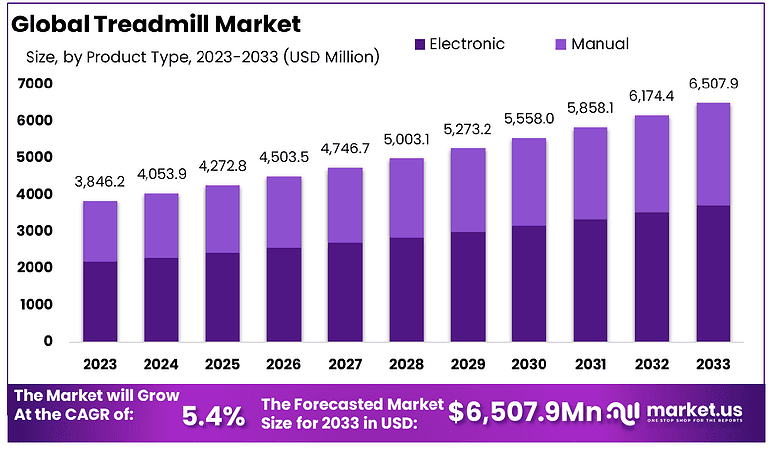
Treadmill Market Overview
Global Treadmill Market Size
- The global treadmill market is projected to exhibit consistent growth from 2023 to 2033 at a CAGR of 5.4%.
- In 2023, the market revenue stood at USD 3,846.2 million.
- The trend persists into the early 2030s, with the market expected to generate USD 6,174.4 million in 2032 and USD 6,507.9 million by 2033.
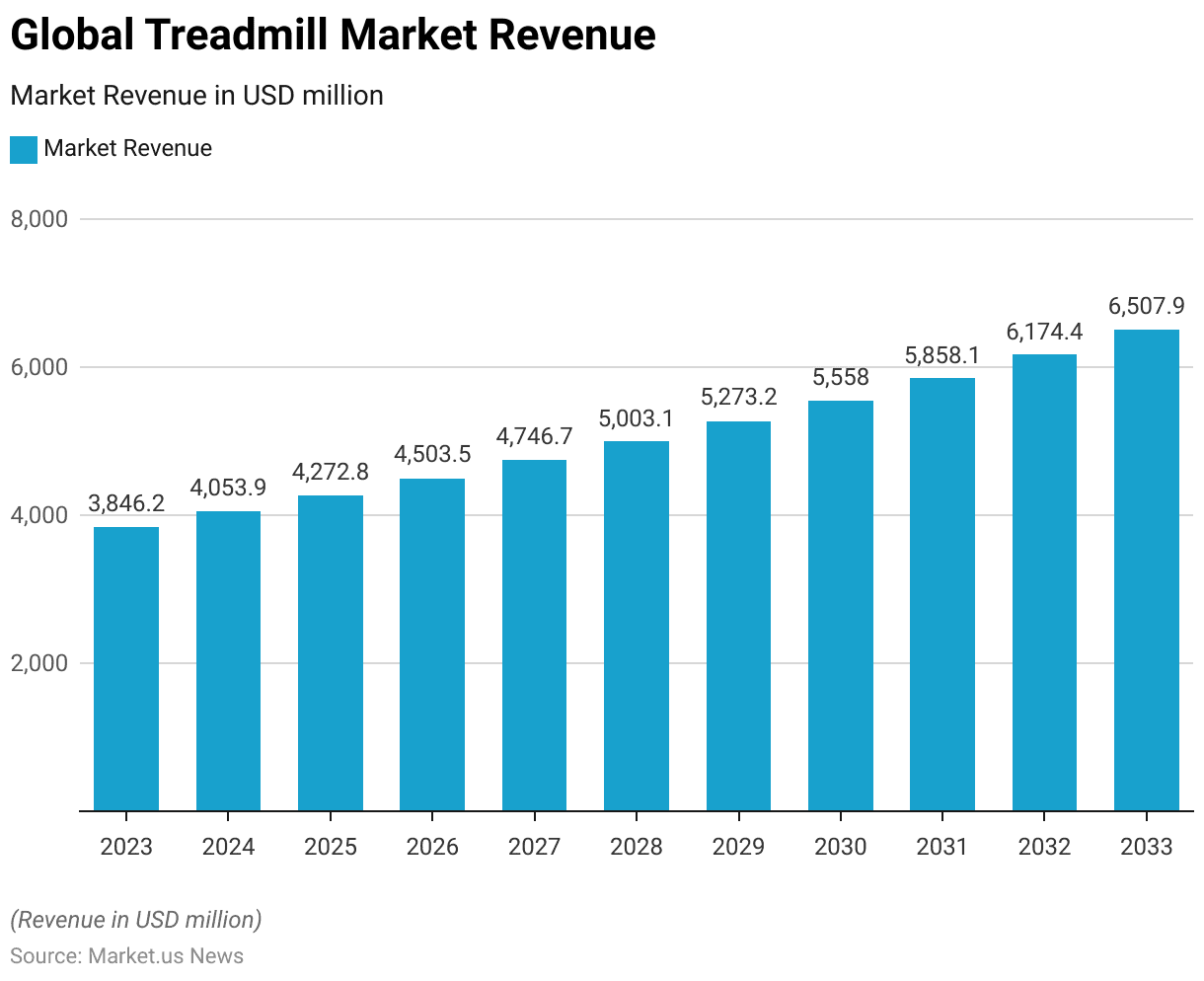
Global Treadmill Market Size – By Product Type
- The global treadmill market, segmented by product type, is forecasted to experience robust growth from 2023 to 2028.
- In 2023, the total market revenue was USD 3,846.2 million. With electronic treadmills contributing USD 2,192.3 million and manual treadmills generating USD 1,653.9 million.
- Finally, by 2033, the market is projected to reach USD 6,507.9 million. With electronic treadmill revenues at USD 3,709.5 million and manual treadmill revenues at USD 2,798.4 million.

History of Treadmills
- The history of treadmills dates back to ancient times and has evolved significantly through various applications.
- Initially used in Roman times around the first century CE as treadwheel cranes for lifting heavy objects. Treadmills found their next prominent use in the early 19th century as punitive devices in prisons.
- English inventor Sir William Cubitt introduced the treadmill in 1817 to reform idle prisoners through hard labor. Which involved the monotonous, strenuous activity of grinding grain or pumping water.
- By the late 19th century, the penal use of treadmills was largely abandoned due to its excessive cruelty.
- The first patent for a treadmill as a fitness device was issued in 1913, and in 1952, Dr. Robert Bruce and Wayne Quinton developed the first medical treadmill to diagnose heart and lung conditions.
- The commercial treadmill for exercise gained popularity in the 1960s and 70s, fueled by Dr. Kenneth Cooper’s promotion of aerobic exercise.
Popular Treadmill Brands
- As of April 2022, NordicTrack emerged as the most commonly owned brand of treadmill in the United States, with 31.9% of respondents indicating ownership of this brand.
- Peloton followed as the second most popular brand, with a 20.5% share of respondents.
- ProForm treadmills were owned by 12.3% of respondents, while Bowflex accounted for 10.5%.
- Both Schwinn and Echelon treadmills were owned by 6.1% of respondents.
- The remaining 12.7% of respondents owned treadmills from various other brands, highlighting a diverse market presence beyond the leading manufacturers.
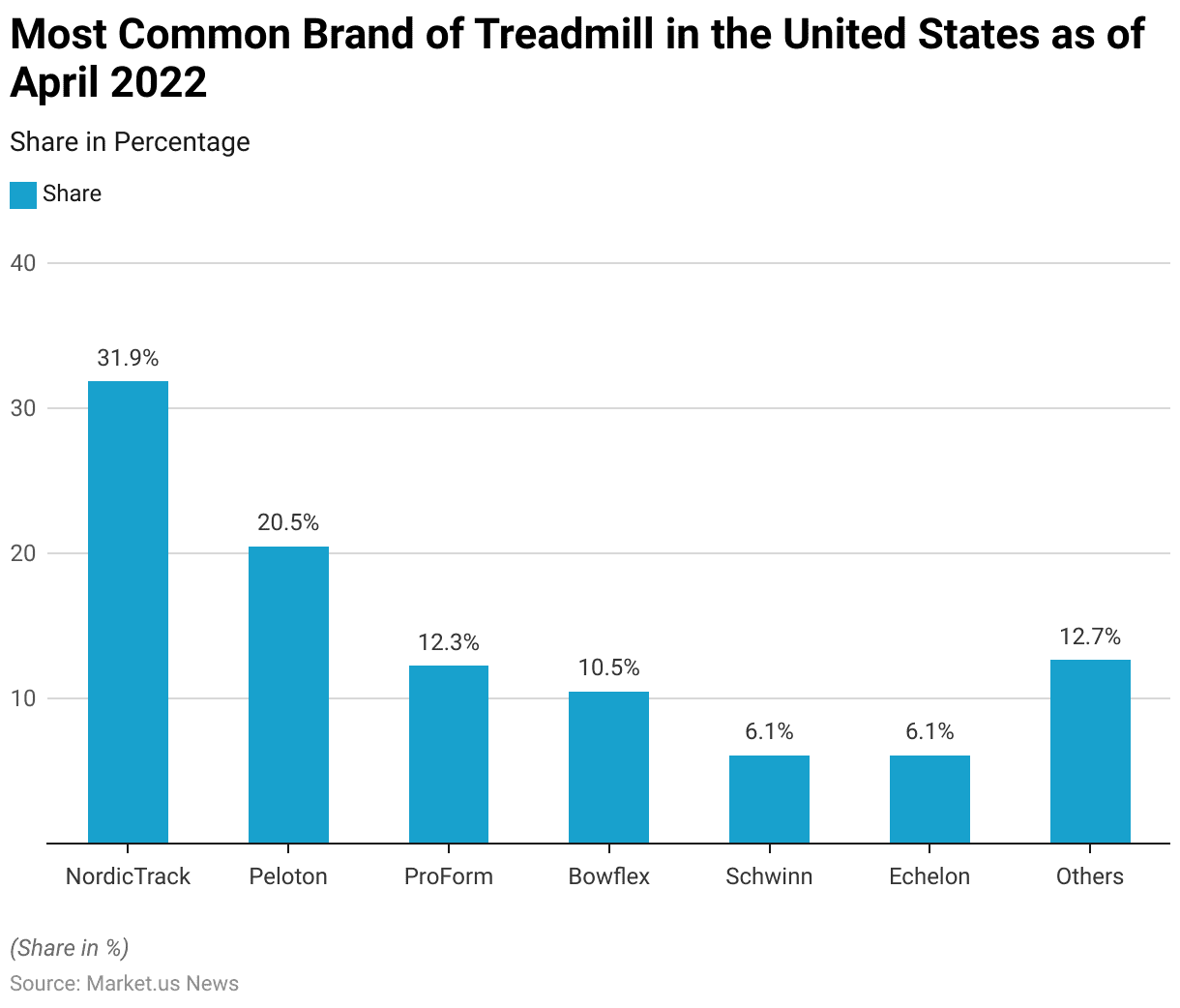
Treadmill Specifications Statistics
General Specifications
- When evaluating treadmill specifications, several key factors must be considered to ensure a comprehensive understanding of the machine’s capabilities and suitability for various fitness needs.
- The weight of the treadmill, which typically ranges between 150 to 345 pounds, influences its stability and portability.
- Rollers, often 2.5 to 3 inches in diameter, affect the smoothness and longevity of the belt.
- Speed capabilities can vary, with many treadmills offering a range from 0.1 to 12 miles per hour.
- Motor capacity, crucial for sustained performance, often ranges from 3.0 to 4.0 horsepower (HP).
- Dimensions, such as those of the Sole F89 (83″ L x 38″ W x 68″ H), dictate the space required for operation and storage.
- Power requirements usually involve standard home electrical systems, like 110 VAC, 50/60Hz, and 15A.
- Incline range is another critical feature, with advanced models offering from -6% decline to a 40% incline, as seen in the NordicTrack X11i, allowing for varied workout intensities.
Treadmill Sales Statistics and Trends
- Wholesale sales of treadmills for consumers in the U.S. have shown notable fluctuations over the period from 2007 to 2018.
- In 2007, wholesale sales reached USD 967 million.
- The market saw another rise in 2018, with wholesale sales peaking at USD 1,034 million. Indicating a strong and growing demand for treadmills in the U.S. market over this period.
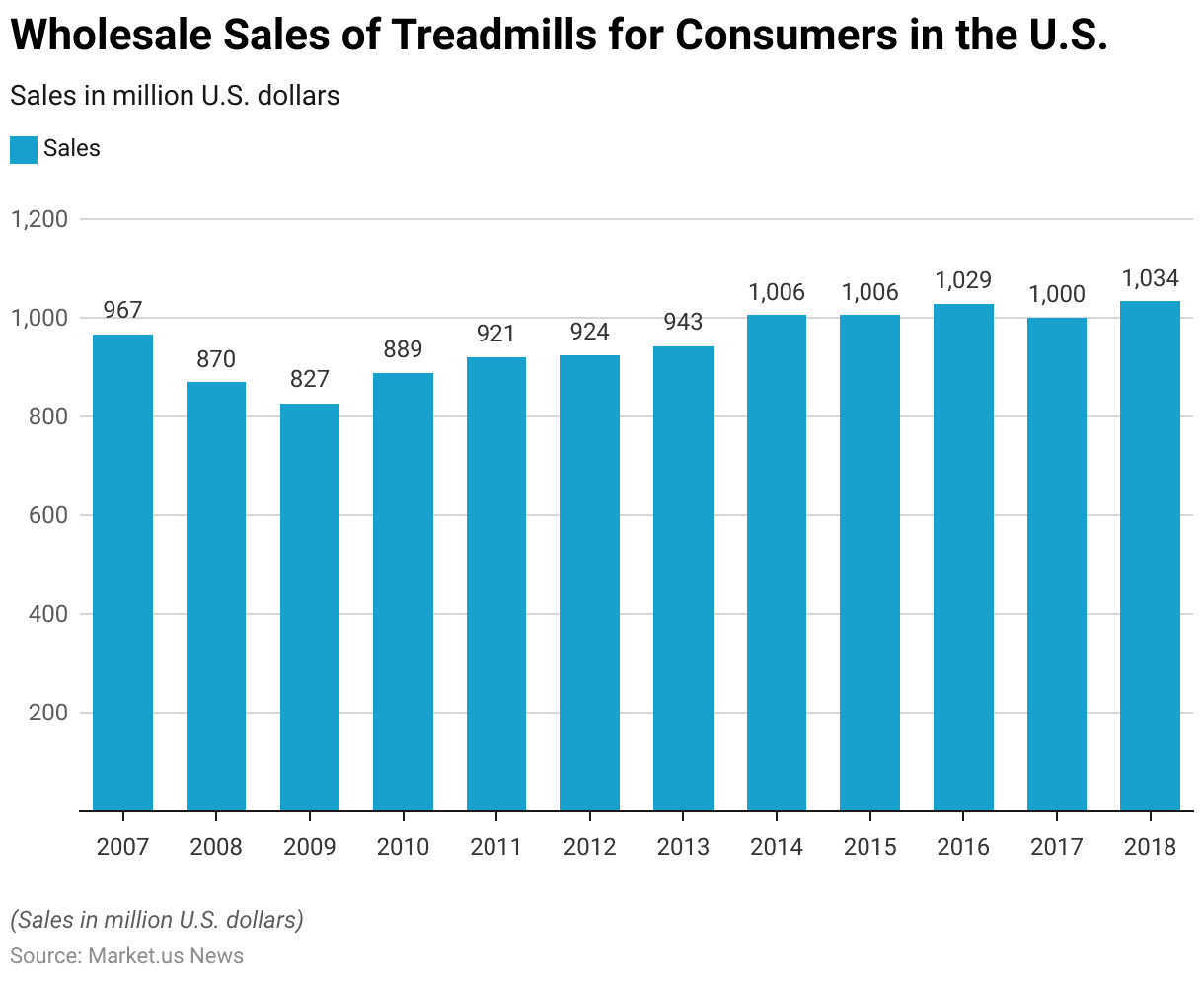
Cost of Treadmills
- The cost of treadmills in the industry varies significantly, ranging from as low as $100 to over $5,000.
- Treadmills priced around $100 are typically from disreputable brands, featuring only basic functionalities and potentially compromising on safety, particularly if purchased second-hand; therefore, such low-cost treadmills are not recommended.
- In contrast, high-quality models, such as the NordicTrack X32i, can be priced around $5,000. Offering advanced features and robust build quality.
- Treadmill costs can be broadly categorized into three segments: Budget treadmills, priced between $100 and $1,000;
- Medium-range treadmills cost between $1,000 and $2,000, and high-quality treadmills cost more than $2,000.
User Preferences and Trends
Type of Treadmill Preferred
- When asked about their preferred type of treadmill, a majority of respondents, 55.5%, indicated a preference for motorless treadmills.
- In contrast, 30% of respondents expressed an interest in motorized treadmills.
- Additionally, 14.4% of respondents were unsure about the difference between motorized and motorless treadmills.
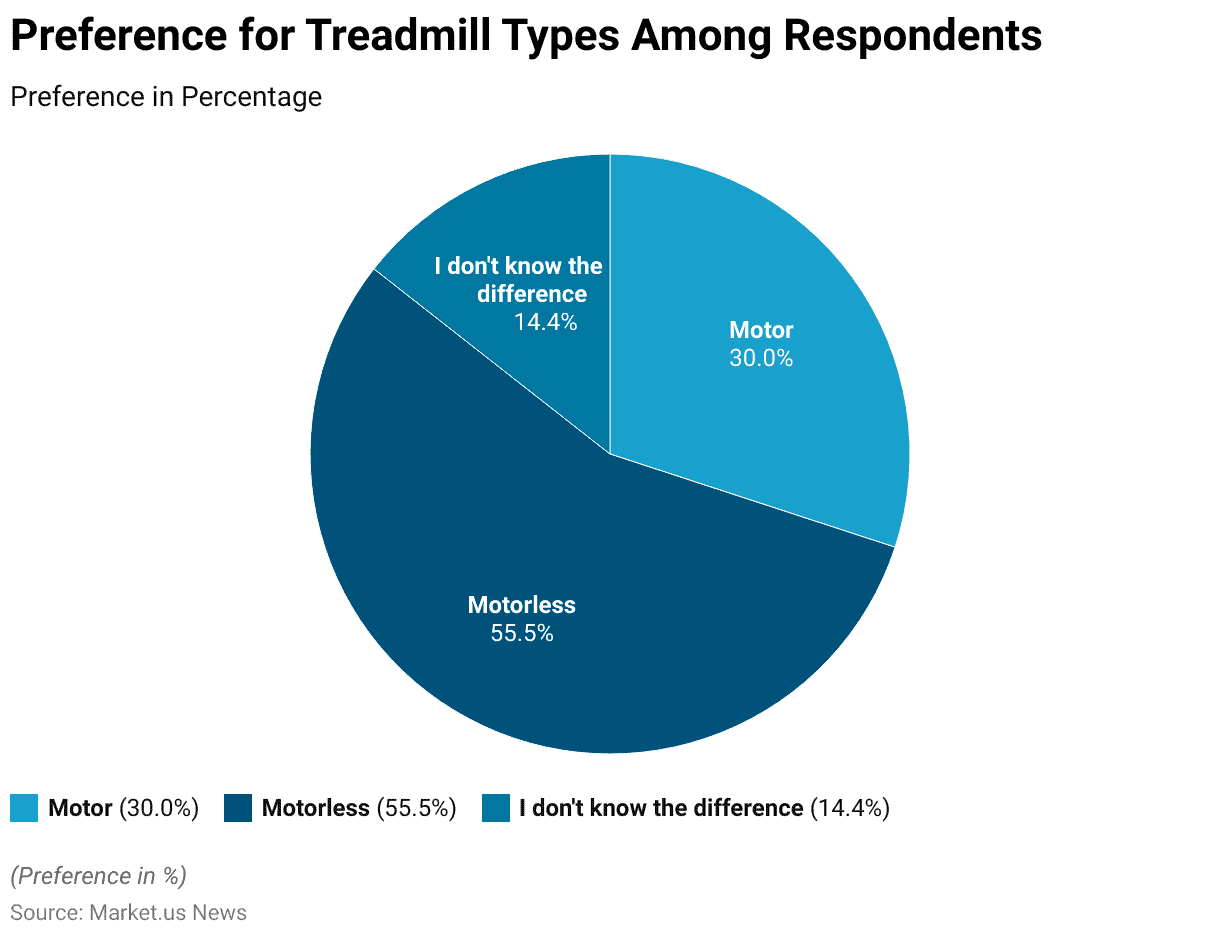
Level of Interest for Motorized Treadmills vs. Non-Motorized Treadmills
- Interest levels for motorized treadmills and non-motorized treadmills exhibit notable differences.
- For motorized treadmills, only 7.25% of respondents reported a high level of interest, 25.49% indicated a medium level of interest, 58.06% expressed a low level of interest, and 9.20% remained neutral.
- In contrast, non-motorized treadmills garnered a higher level of interest, with 18.26% of respondents showing high interest, 30.98% medium interest, 39.26% low interest, and 6.24% neutral.
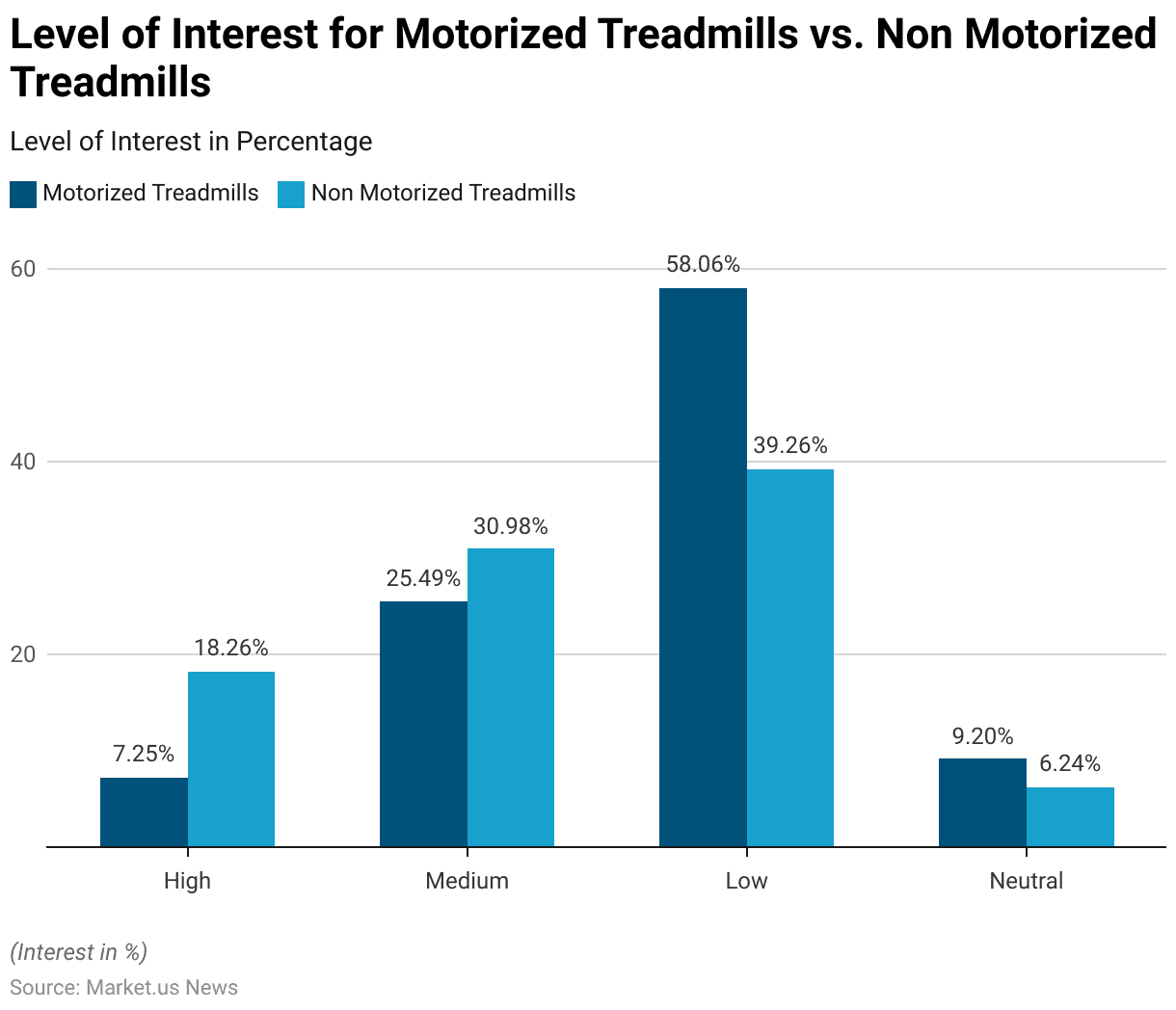
Technological Advancements in Treadmills
- Technological advancements have significantly transformed the fitness industry, making workouts more engaging and effective.
- Modern treadmills now feature interactive touchscreens, Bluetooth connectivity, and built-in speakers to enhance user experience.
- Innovations such as virtual fitness running trails, gamification with leaderboards and reward points, and compatibility with fitness apps like Zwift provide immersive and entertaining workout sessions.
- Non-motorized treadmills like the AssaultRunner Pro offer a unique curved design to reduce joint stress, while foldable models like the WalkingPad A1 Pro cater to space-conscious users with their compact, quiet operation.
Regulations for Treadmills
- Regulations vary by country and encompass several aspects, such as safety standards, electrical requirements, and restrictions on hazardous substances.
- In the United States, treadmill regulations include compliance with standards set by the Consumer Product Safety Improvement Act (CPSIA), the Federal Communications Commission (FCC) Part 15 for radiofrequency devices, and energy-efficient standards under 10 CFR Part 430.
- Additionally, treadmills must meet the American Society for Testing and Materials (ASTM) standards, particularly ASTM F2115-18 for motorized treadmills.
- In the European Union, regulations such as the Restriction of Hazardous Substances (RoHS) Directive and the Radio Equipment Directive (RED) apply, along with the requirement for CE marking to indicate conformity with EU standards.
- Australia follows its own set of standards, including compliance with the Trade Practices (Consumer Product Safety Standard) Regulations 2009, which stipulate safety and labeling requirements for treadmills.
Discuss Your Needs With Our Analyst
Please share your requirements with more details so our analyst can check if they can solve your problem(s)




